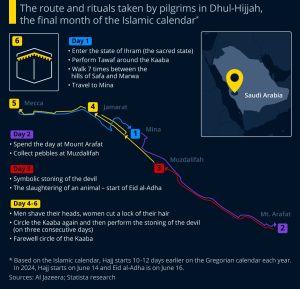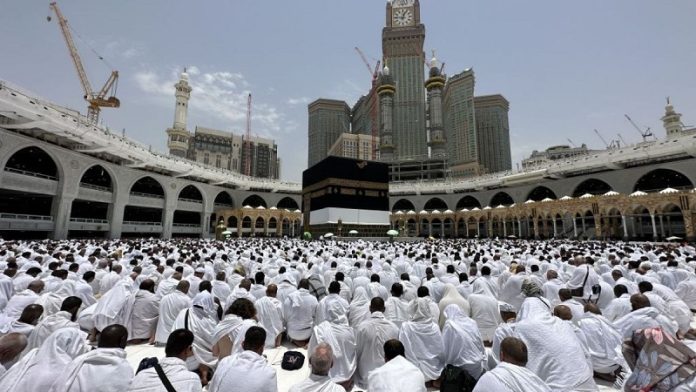Sunday marks the celebration Eid al-Adha, a festival of sacrifice, which falls on the 10th day of the final month of the Islamic calendar, Dhul-Hijjah.
Eid al-Adha is a three-day long celebration, and requires the sacrificing of an animal, commemorating Abraham’s willingness to sacrifice his son. The sacrificial meat is then given to the poor as well as partly to the family and neighbors.
Today, it is customary that pilgrims pay for a token to cover the cost of an animal that is either slaughtered in an abattoir in the holy city of Mecca, or else to donate money for sacrificial meat to be sent to Muslim communities in need abroad, with this year the focus on Gaza.
 This infographic, based on reporting from Al Jazeera, shows some of the main steps taken during the Hajj pilgrimage in Saudi Arabia, including Eid al-Adha, which falls on the third day of Hajj.
This infographic, based on reporting from Al Jazeera, shows some of the main steps taken during the Hajj pilgrimage in Saudi Arabia, including Eid al-Adha, which falls on the third day of Hajj.
As shown in the infographics, pilgrims begin their journey by entering the holy state of Ihram, which involves, among other rituals, men dressing in two white cloths named the izar and rida, while women don a loose dress that covers the body save for their hands and face. Only then will pilgrims cross the threshold of the city of Mecca, where solely Muslims are permitted.
Worshippers will then perform the Tawaf, or the circling of the Kaaba, a black stone structure located in the middle of the al-Masjid al-Haram, or the Holy Mosque, counterclockwise seven times, reciting prayer.
Another practice performed is the sa’y, which entails walking or running back and forth between the nearby hills of Safa and Marwah, before traveling to Mina.
The pilgrimage continues on to Mount Arafat for the offering of prayers, with worshippers standing in vigil until sunset, seeking forgiveness for their sins.
On the planes of Muzdalifah, worshippers will then collect between 49-70 pebbles, seven of which are later thrown at the largest of three pillars (Jamrat al-Aqabah) in a symbolic stoning of the devil.
After this comes the slaughtering of an animal on Eid al-Adha. Only then will men shave their heads, while women cut a lock of their hair to symbolize the rebirth of their spiritual journey.
Over the next few days, pilgrims will perform Tawaf again, before performing the ritual of the stoning of the devil, this time at each of three walls (formerly pillars), on three successive days.
While the pattern of pilgrimage rites was established by the Prophet Mohammad, pilgrims might visit the Meccan sites in different orders. However, it is customary to perform a final farewell circle of the Kaaba.
Most Muslims will also head to Medinah, the second holiest city in Islam, either before or after completing the Hajj pilgrimage.
The Hajj pilgrimage usually takes 5-6 days and is a requirement of every adult Muslim to complete at least once in their lifetime, so long as they are financially, physically and emotionally able for it.
It is the fifth and final of the Five Pillars of Islam, following after Shahada (the declaration of faith in one God (Allah) and His messenger (Muhammad), Salah (ritual prayer five times a day), Zakat (a form of giving to charity) and Sawm (fasting at Ramadan).
Anna Fleck writes for Statista


